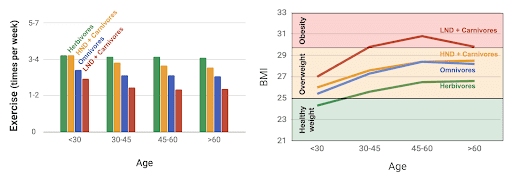By Rafaela Bagur Quetglas, PhD
It turns out your age, gender and diet all affect how often you exercise, according to new data from 23andMe.

As part of our ongoing health research, 23andMe’s scientists looked at whether a person’s age, gender, or diet might be associated with exercise. Understanding the relationship between those factors may help in our understanding of contributors to maintaining a healthy weight. Our scientists analyzed the data of more than 850,000 people who consented to participate in research and who shared details about their own eating and exercise habits.
Age Matters
Are people over 30 more sedentary than people under 30? Among 23andMe participants, the answer is yes! The percent of people who don’t exercise for 30 minutes or more at least once a week increases with age. (Figure 1, left panel) We also observed a decrease in the percent of people who exercise once or twice a week over age 45.
Interestingly, the percentage of people who reported exercising three or four times a week is constant, independent of the participants’ age. This suggests that at least among some of the most active individuals, age doesn’t matter.
Another surprise is that the relationship between how often we exercise and our BMI is different depending on our age (Figure 1, right panel). In general, the more active you are, the lower your BMI. But the difference in BMI between sedentary and physically active people is bigger for adults over 30 than it is for adults under 30. In fact, this difference seems to increase with age until about 60.
This could reflect a cumulative effect rather than the effect of exercise at a particular age. Epidemiologic studies have shown that on average we gain 1-2 lbs per year from early adulthood through middle age [1]. However, one could hypothesize that the weight gain per year might depend on exercise frequency, thus resulting in a difference of weight between sedentary and physically active people dependent on age. This is not the only possible explanation since multiple lifestyle factors that influence weight are affected by aging such as our metabolism, physical activity baseline or even sleep duration. Although the main explanation behind this result isn’t perfectly clear, what is well-known are the health benefits of exercising at any age [2][3].

Figure 1. Left graph represents the percent of participants who exercise for at least 30 min, from zero times per week to daily, broken down by age. Right graph shows the difference in BMI between sedentary participants and those exercising from at least one time a week to multiple times a day, also broken down by age.
Exercise and BMI Differences between Men and Women
Who exercises more, men or women?
On average we found that men in our study tend to be more active than women. Only 12% of men that participated in this research reported to be sedentary, while in women this number was up to 16%. However, the relationship between exercise frequency and gender gets more complex when we break the participants answers down by age. Women under 30 were more likely to report exercising less than twice per week, and they were less likely than men to report exercising five or more times per week (Figure 2). But, this difference in exercise frequency between men and women shrinks with age. In fact, the exercise pattern over age 45 is fairly similar between men and women.
Physical activity was not the only difference between genders.
We found that the difference in BMI between people who exercise and people who are sedentary is higher in women than in men. For instance women of average height (5 feet 4 inches) who exercises 5-7 times per week for at least 30 minutes weight on average 37.5 lbs less than sedentary women of the same age and height. In men this difference in weight is smaller than that observed in women. Men of average height (5 feet 9 inches) exercising 5-7 times per week tend to weigh on average 26.5 lbs less than sedentary men of the same age and height.
It’s important to highlight that BMI is a measure of weight adjusted for height, but it doesn’t take body composition into account. So, higher BMI doesn’t necessarily mean higher fat composition. Athletic people are more likely to have higher bone density and muscular mass, and therefore a higher BMI than sedentary people. Therefore, it might be plausible that the gender-specific difference in BMI between sedentary and athletic people is influenced by men’s testosterone levels, which increase their capacity to build more muscle mass on average than women [4]. Building muscle mass is also influenced by the type of exercise (e.g., strengthening vs. aerobic), which wasn’t considered in this analysis.

Figure 2. Barcharts represents the percent of participants divided by gender. These seoarated exercise for at least 30 min from zero times per week to daily at the age of under 30 (left) or between 45 and 60 (right). The line chart shows the difference in BMI between participants (divided by gender) exercising at least one time a week compared to sedentary.
Diet and Exercise
It’s clear that your diet has an impact on your weight, but does what you eat indicate how active you are?
In turns out that it does, or at least we see an association between diet and exercise. It’s important to note that an association does not mean causation. At the same time it’s worth exploring how diet and exercise are related.
In a previous blog post, we identified four different diet groups (Figure 3) in the 23andMe community. We also identified the major traits associated with the groups. These diet groups were mainly characterized by two dietary behaviors: the nutrient content of the food eaten and meat intake.
Using these two behaviors as axes, we can plot the four main diet groups.
- On one end, we find people who eat high nutrient-dense (HND) foods. These include vegetables, leafy greens and fruits. These individuals also tend to avoid high caloric foods with low nutrient content. These foods include foods with refined carbs, or processed foods, or foods with saturated fats or fast food. Depending on their meat intake, these people can either be classified as HND + Carnivores (high meat intake) or Herbivores (low meat intake).
- On the other end, we find people with a diet low in vegetables, leafy greens and fruits. They tend to eat more high calorie foods with low nutrient content, low nutrient-dense foods (LND). People in this group also tend to eat more meat, particularly processed and red meat (LND + Carnivores).
- Finally, the people in the middle we called Omnivores because they ate a little of everything.

Figure 3. Left graph represents the four defined diets projected in the two main behaviors axis (nutrient content of foods and meat intake). Right panel describes the nutritional differences between these diets. The dots represent the average response to the survey question: “How frequently do you eat this food?” Possible responses were: “not at all” (all dots empty), “1-2 times per week” (one filled dot), “3-6 times per week” (two filled dots), “once per day” (three filled dots) or “more than once a day” (all dots filled).
We looked at the amount of exercise in a typical week. Then we broke that down by participants’ diet groups. We observed that people in the Herbivore and HND + Carnivore groups exercise more often than people in the Omnivores and LND + Carnivore groups. (Figure 4) What’s more, people in the Herbivore group have on average a lower BMI than people of the same age in any other diet group. Although weight tends to increase through midlife, the relationship between what we eat and how much we exercise is fairly consistent, regardless of our age.

Figure 4. Barchart representing the average amount of exercise per week that participants belonging to different diets and age groups present. Right plot shows the average BMI associated to participants that belong to different diets and age groups.
The Takeaway
In this study, we observed differences in physical activity in the 23andMe research community broken down by age, sex, and diet behaviors. Our scientists showed that the relationship between exercise and BMI strongly depend on people’s age and gender. Moreover, people’s nutrition habits is highly associated with exercise frequency. So that people who eat high nutrient dense foods are also likely to exercise more.
We would like to thank the 23andMe customers who made this study possible by participating in research.
Rafaela Bagur Quetglas is a Data Scientist in Health Research and Development at 23andMe.
Footnotes:
[1] Hutfless S. et al., (2013) Strategies to Prevent Weight Gain Among Adults. Rockville (MD): Agency for Healthcare Research and Quality (US); Report No.: 13-EHC029-EF.
[2] Donald M. Lyall et al., (2017) Association of Body Mass Index With Cardiometabolic Disease in the UK Biobank: A Mendelian Randomization Study. JAMA Cardiol. 10.1001/jamacardio.2016.5804
[3] Bhaskaran K. et al., (2014) Body-mass index and risk of 22 specific cancers: a population-based cohort study of 5·24 million UK adults. Lancet. 10.1016/S0140-6736(14)60892-8
[4] Janssen I, et al., (2000) Skeletal muscle mass and distribution in 468 men and women aged 18–88 yr J Appl Physiol. 10.1152/jappl.2000.89.1.81